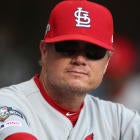ST. LOUIS -- Prominent among the 2019 postseason subplots is the controversy over the baseball itself. The baseballs used during the regular season certainly seemed to be hopped up, as home run records at the team and league level tottered and fell with regularity. Yes, a league-wide emphasis on launch angle and lifting the ball played a role, but it's mostly about the baseball. That the Triple-A level also used the same baseball and saw unprecedented levels of offense is yet another data point.
Then, however, the playoffs happened. During the 2019 regular season, teams averaged 1.39 home runs per game, the highest figure in MLB history. Thus far in the playoffs, that figure has dropped to 1.24 per game. That may not sound like much, but scaled to a full season that's a decline of roughly 730 home runs, league-wide. The difference is even more stark when you look at run-scoring as a whole. During the 2019 regular season, teams averaged 4.83 runs per game. During the playoffs thus far, teams are averaging just 4.00 runs per game. We haven't seen those levels over a full season since the 1970s.
It's also worth noting that Game 1 of the NLCS was the first game of this postseason that saw true fall temperatures, and cooler temps are of course less conducive to hitting for power. Going forward, the crisp air may become mitigating evidence, but it explains very little of what's happened thus far. In fact, average postseason temps prior to Game 1 in St. Louis were higher than average regular season temps this year.
In the second inning of NLCS Game 1 in St. Louis, Cardinals power threat Marcell Ozuna blasted a cutter to the warning track in center. It left the bat at 106 mph and with a launch angle of 36 degrees. That's a home run 70 percent of the time, but in this instance the ball settled into Michael Taylor's glove just in front of the wall. It's one ball, but it resonated at something out of the ordinary to everyone who saw it.
"I thought Ozuna got his ball, based on the sound, based on the swing," said Cardinals manager Mike Shildt on Saturday. "But clearly it didn't get out. And you kind of realized then we were dealing with an evening where the ball wasn't going to carry as much."
And then Shildt continued:
"I guess -- I don't guess, our front office analytical group is saying the ball's not traveling at about a four-and-a-half foot difference."
Four-and-a-half feet is substantial, to say the least, and that's not just Shildt speaking idly -- the club has the numbers. In his press conference before Game 2, Shildt's counterpart, Nationals manager Davey Martinez, said he played his outfielders shallower than usual because, in his words, "we figured the ball was not going to travel as far."
During the course of the Nationals triumph over the Dodgers in the NLDS, Los Angeles manager Dave Roberts said the ball "doesn't seem like it's traveling."
Perhaps most tellingly, Rob Arthur of Baseball Prospectus discovered that the "drag" on playoff baseballs -- i.e., how susceptible the baseball is to air resistance -- increased dramatically just as the playoffs began. Running counter to all this, and Arthur's piece in particular, MLB insists that the postseason baseball comes from the same regular season batch. Here's the recent statement from the league:
The baseballs used in Major League Baseball are manufactured in batches. Balls that are used in the Postseason are pulled from the same batches as balls used in the regular season. Regular season and Postseason balls are manufactured with the same materials and under the same processes. The only difference is the Postseason stamp that is placed on the ball. As has been previously acknowledged, however, the drag of the baseball can vary over different time periods.
Of course, Arthur's research shows that the odds are remote that the regular season batch of baseballs could produce these outcomes. Now we have an indication that the Cardinals' own data puts a very specific number on it.
None of this is particularly scandalous, short of MLB's possible lack of forthrightness on the matter, but taking the legs out of the current structure of the game just as the most important part of the baseball calendar begins is something for which the league should answer. At the very least, the league should answer better than it has. As for the remainder of us, we should probably account for this very different baseball and adjust our expectations about how the 2019 postseason will unfold.


















